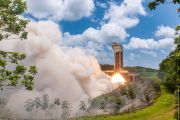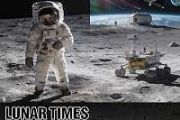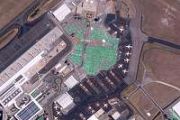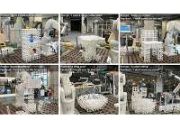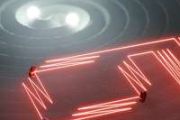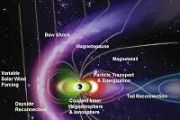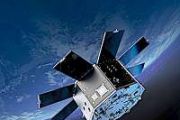
Copernical Team
Raytheon Technologies develops 'NexGen Optix' Tactical Free-Space Optical Comms
 Raytheon Technologies (NYSE: RTX), announced the launch of NexGen Optix, a tactical Free-Space Optical Communications system that enables high-speed, secure data transfer in challenging environments.
NexGen Optix, developed by Raytheon Blackbird Technologies, provides greater bandwidths in a form factor that is smaller, weighs less, uses less power and costs less than conventional optical
Raytheon Technologies (NYSE: RTX), announced the launch of NexGen Optix, a tactical Free-Space Optical Communications system that enables high-speed, secure data transfer in challenging environments.
NexGen Optix, developed by Raytheon Blackbird Technologies, provides greater bandwidths in a form factor that is smaller, weighs less, uses less power and costs less than conventional optical Speedy composite manufacturing
 An Oak Ridge National Laboratory-developed advanced manufacturing technology, AMCM, was recently licensed by Orbital Composites and enables the rapid production of composite-based components, which could accelerate the decarbonization of vehicles, airplanes and drones.
Additive manufacturing compression molding, or AMCM, uses short-fiber-filled polymer and continuous fiber to print directl
An Oak Ridge National Laboratory-developed advanced manufacturing technology, AMCM, was recently licensed by Orbital Composites and enables the rapid production of composite-based components, which could accelerate the decarbonization of vehicles, airplanes and drones.
Additive manufacturing compression molding, or AMCM, uses short-fiber-filled polymer and continuous fiber to print directl US regulator targets AI ahead of White House confab
 A US regulator put artificial intelligence in the crosshairs ahead of a White House meeting Thursday with tech firms to strategize about its dangers.
"While the technology is moving swiftly, we already can see several risks," Federal Trade Commission chief Lina Khan wrote in a guest essay in the New York Times.
"Enforcers and regulators must be vigilant."
The tough talk comes as US l
A US regulator put artificial intelligence in the crosshairs ahead of a White House meeting Thursday with tech firms to strategize about its dangers.
"While the technology is moving swiftly, we already can see several risks," Federal Trade Commission chief Lina Khan wrote in a guest essay in the New York Times.
"Enforcers and regulators must be vigilant."
The tough talk comes as US l NOAA's GOES-U completes solar array deployment test
 Washington DC (SPX) May 04, 2023
GOES-U, the fourth and final satellite in NOAA's GOES-R Series, recently completed a successful test deployment of its solar array to ensure it will function properly in space.
This critical test verified that the satellite's large, five-panel solar array - which is folded up when the satellite is launched - will properly deploy when GOES-U reaches geostat
Washington DC (SPX) May 04, 2023
GOES-U, the fourth and final satellite in NOAA's GOES-R Series, recently completed a successful test deployment of its solar array to ensure it will function properly in space.
This critical test verified that the satellite's large, five-panel solar array - which is folded up when the satellite is launched - will properly deploy when GOES-U reaches geostat Construction begins at UK's first vertical launch spaceport
 Orbex has announced that construction has begun at Sutherland Spaceport (formerly known as Space Hub Sutherland) in Scotland, making this the first vertical launch spaceport to be built on the UK mainland. Located on the North coast of Scotland, the spaceport will be the 'home' spaceport of Forres-based rocket and launch services company, Orbex, which will use the site to launch up to 12 orbital
Orbex has announced that construction has begun at Sutherland Spaceport (formerly known as Space Hub Sutherland) in Scotland, making this the first vertical launch spaceport to be built on the UK mainland. Located on the North coast of Scotland, the spaceport will be the 'home' spaceport of Forres-based rocket and launch services company, Orbex, which will use the site to launch up to 12 orbital Hunting for life's building blocks at minus 250 degrees Celsius
 Searching for life's building blocks lightyears away is an important task of the James Webb Space Telescope. But how does it know what to look for? PhD student Marina Gomes Rachid is offering a helping hand by mapping out molecules that could exist in deep space.
Imagine the headlights of a car on a misty day. A beam of light becomes visible in the fog, revealing particles of moisture floa
Searching for life's building blocks lightyears away is an important task of the James Webb Space Telescope. But how does it know what to look for? PhD student Marina Gomes Rachid is offering a helping hand by mapping out molecules that could exist in deep space.
Imagine the headlights of a car on a misty day. A beam of light becomes visible in the fog, revealing particles of moisture floa Hubble follows shadow play around planet-forming disk
 Our universe is so capricious it sometimes likes to play a game of hide and seek. In 2017, astronomers were surprised to see a huge shadow sweeping across a disk of dust and gas encircling the nearby young star TW Hydrae. The shadow is cast by an inner disk of dust and gas that is slightly tilted to the plane of the outer disk. The shadow can only be clearly seen because the system is tilted fac
Our universe is so capricious it sometimes likes to play a game of hide and seek. In 2017, astronomers were surprised to see a huge shadow sweeping across a disk of dust and gas encircling the nearby young star TW Hydrae. The shadow is cast by an inner disk of dust and gas that is slightly tilted to the plane of the outer disk. The shadow can only be clearly seen because the system is tilted fac Neutron star's X-rays reveal 'photon metamorphosis'
 A "beautiful effect" predicted by quantum electrodynamics (QED) can explain the puzzling first observations of polarized X-rays emitted by a magnetar - a neutron star featuring a powerful magnetic field, according to a Cornell astrophysicist.
The extremely dense and hot remnant of a massive star, boasting a magnetic field 100 trillion times stronger than Earth's, was expected to generate h
A "beautiful effect" predicted by quantum electrodynamics (QED) can explain the puzzling first observations of polarized X-rays emitted by a magnetar - a neutron star featuring a powerful magnetic field, according to a Cornell astrophysicist.
The extremely dense and hot remnant of a massive star, boasting a magnetic field 100 trillion times stronger than Earth's, was expected to generate h Cosmonauts transfer airlock between ISS modules
 Russian Roscosmos cosmonauts, Sergey Prokopyev and Dmitri Petelin completed a spacewalk Wednesday to transfer an equipment airlock from one module of the International Space Station to another.
While Prokopyev and Petelin were outside assisting, a third cosmonaut, Andrey Fedyaev, stayed inside the station to operate the European Robotic Arm to move the airlock from the station's Rassvet
Russian Roscosmos cosmonauts, Sergey Prokopyev and Dmitri Petelin completed a spacewalk Wednesday to transfer an equipment airlock from one module of the International Space Station to another.
While Prokopyev and Petelin were outside assisting, a third cosmonaut, Andrey Fedyaev, stayed inside the station to operate the European Robotic Arm to move the airlock from the station's Rassvet SpaceX lifts another 56 Starlink satellites into lower Earth orbit
 SpaceX carried another 56 Starlink Internet satellites into space from the Cape Canaveral Space Station on Thursday morning, its 27th orbital mission on its workhorse Falcon 9 rocket this year.
The satellites released into lower Earth orbit on Thursday will enable Internet users around the world to connect online to remote and far-flung regions of Earth. For SpaceX, the successful launc
SpaceX carried another 56 Starlink Internet satellites into space from the Cape Canaveral Space Station on Thursday morning, its 27th orbital mission on its workhorse Falcon 9 rocket this year.
The satellites released into lower Earth orbit on Thursday will enable Internet users around the world to connect online to remote and far-flung regions of Earth. For SpaceX, the successful launc 










